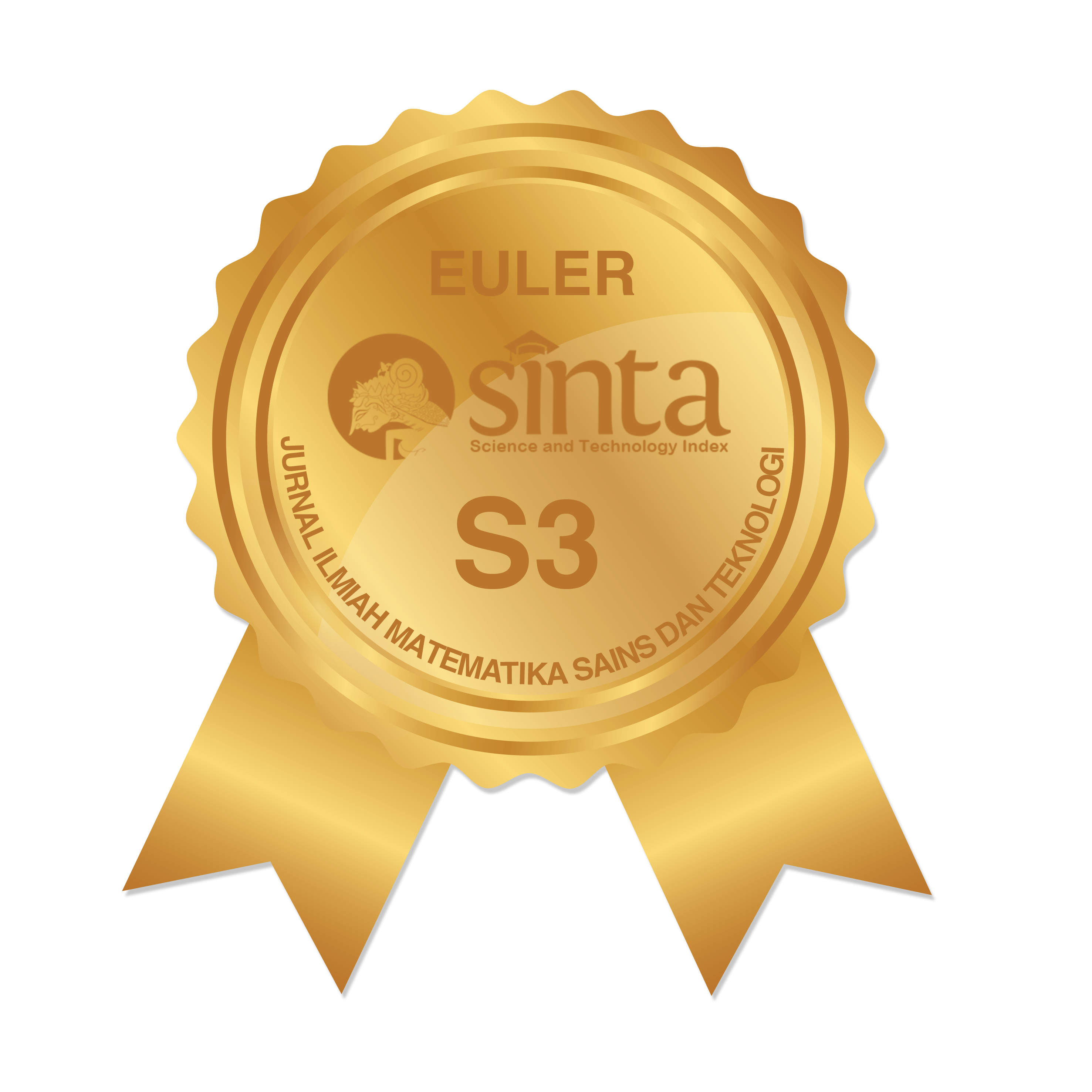Bifurkasi Hopf Pada Model Siklus Bisnis Investment Saving-Liquidity Money dengan Waktu Tunda
Abstract
Keywords
Full Text:
PDFReferences
L. P. Sinaga, D. Kartika & H. Nasution, Pengantar Sistem Dinamik: Amal Insani, Banten, 2021
C. Ragan & R. Lipsey, Economics, Thirteenth Canadian Edition: Pearson Canada, Toronto, 2017
C. Seftarita, Kebijakan Ekonomi Makro dan Siklus Bisnis; Kajian Teori dan Studi Empiris: Syiah Kuala University Press, Banda Aceh, 2014.
E. H. Nugrahani, P. Sianturi & Rosmely, Analisis bifurkasi pada model siklus bisnis IS-LM (Investment Saving-Liquidity Money): IPB Bogor, 2016.
L. Guerrini, A. Krawiec & M. Szydlowski, "Bifurcation in a economic growth model with a distributed time delay transformed to ODE", Nonlinear Dyn, vol. 101, pp. 1263-1279, 2020. doi: https://doi.org/10.1007/s11071-020-05824-y
F. Karim, S. Chauhan, S. k. Bhatia, "Hopf Bifurcation in an Augmented IS-LM Linear Business Cycle Model with Two Time Delays", International Journal of Mathematical, Engineering and Management Sciences, vol. 5, no. 3, pp. 518-528,2020. doi: https://doi.org/10.33889/IJMEMS.2020.5.3.043
Y. Xie, Z. Wang, and B. Meng, "Stability and Bifurcation of a Delayed Time-Fractional Order Business Cycle Model with a General Liquidity Preference Function and Investment Function",mathematics, vol. 7, no. 846, 2019. doi: https://doi.org/10.3390/math7090846
A. N. Hidayati, E. Apriliani, I. G. R. Usadha, "Optimal Control Of Dynamic IS-LM Bussiness Cycle Model With Two Time Delay"Journal of Physics: Conference Series, vol. 1373, 2019. doi: https://doi.org/10.1088/1742-6596/1373/1/012038
U. M. Musyaffafi, M. Hafiyusholeh, Y. Farida, A. Fanani, A. Z. Arifin, "Stability Analysis of Cycle Business Investment Saving-Liquidity Money (IS-LM) Model using Runge-Kutta Fifth Order and Extended Runge-Kutta Method" BEST ICON, pp. 240-246, 2018. doi: https://doi.org/10.5220/0008905402400246
F. Karim, S. Chauhan, J. Dhar, "On the Comparative analysis of linear and nonlinear business cycle model: Effect on system dynamics, economy and policy making general" Quantitative Finance and Economics, vol. 4, Issue 1, pp. 172-203. doi: https://doi.org/10.3934/QFE.2020008
M. Assous, A. Dutt, P. Fourchard, A. Pottier"In Stability in Kalecki's Early Macroeconomics" Journal of the History of Economics Thought, vol. 39, Special Issue 1, pp.69-87, March 2017. doi: https://doi.org/10.1017/S1053837216001097
E. S. Kurkina, "Mathematical Models of Investment Cycles"Computational Mathematics and Modeling, vol. 28, no. 3, July, 2017. doi: https://doi.org/10.1007/s10598-017-9371-4
I. Bashkirtseva, L. Ryashko, dan A. Sysolyatina, Analysis of stochastic effects in Kaldor type business cycle discrete model. Communication in Nonlinear Science and Numerical Simulation, Vol.36, pp.446 - 456, 2016. doi: https://doi.org/10.1016/j.cnsns.2015.12.020
I. Bashkirtseva, L. Ryashko, dan T. Ryazanova, Stochastic sensitivity analysis of the variability of dynamics and transition to chaos in the business cycles model, Communication in Nonlinear Science and Numerical Simulation, Vol.54, pp.174 - 184, 2018. doi: https://doi.org/10.1016/j.cnsns.2017.05.030
E. Cahyono, L. O. Saidi, Makkulau, M. Syarif, dan R. Raya. Quantitative aspects of business/economic cycle. Proceeding of the 3rd SHIELD International Conference, pp.56-64, 2018
J. Kodera, J. Radova, and T. V. Quang, A Modification of Kaldor-Kalecki Model and its Analysis, 30th International Conference Mathematical Methods in Economics, pp.420-425, 2012
N. G. Mankiw, Principles of Economics, South Western: Cengage Learning, 2017
M. U. Syarif, E. Cahyono, dan P. Adam, Study on business cycle in Indonesian economy: A signal processing approach. Global and Stochastic Analysis. Vol. 5 [6], pp.35-43, Special Issue 2018
B. Volna"Relaxation Oscillations in New IS-LM Model" Dynamical Ssytems (math. DS), vol. 95, no. 3, pp.661-667
G. Gabisch, H.W. Lorenz, Business cycle theory - A survey of methods and concepts (Second Edition): Springer, New York, 1989.
J. P. Cai, "Hopf bifurcation in the IS-LM business cycle model with time delay", Electronic Journal of Differential Equations,no. 15,pp.1-6, 2005
Kaldor N, "A Model of the Trade Cycle", Economic Journal, vol.50, 78-92, 1940
V. Torre, "Existence of limit cycles and control in complete Keynesian systems by theory of bifurcations", Econometrica, vol.45, pp. 1457-1466, 1977
M. Kalecki, A macrodynamic theory of business cycle, Econometrica, vol. 3, pp.327-344, 1935
DOI: https://doi.org/10.34312/euler.v10i2.16726
Refbacks
- There are currently no refbacks.
Copyright (c) 2022 Gesti Essa Waldhani

This work is licensed under a Creative Commons Attribution-NonCommercial 4.0 International License.
Euler : Jurnal Ilmiah Matematika, Sains dan Teknologi has been indexed by:
EDITORIAL OFFICE OF EULER : JURNAL ILMIAH MATEMATIKA, SAINS, DAN TEKNOLOGI |
 | Department of Mathematics, Faculty of Mathematics and Natural Science, Universitas Negeri Gorontalo Jl. Prof. Dr. Ing. B. J. Habibie, Tilongkabila, Kabupaten Bone Bolango 96554, Gorontalo, Indonesia |
 | Email: [email protected] |
 | +6287777-586462 (WhatsApp Only) |
 | Euler : Jurnal Ilmiah Matematika, Sains dan Teknologi (p-ISSN: 2087-9393 | e-ISSN:2776-3706) by Department of Mathematics Universitas Negeri Gorontalo is licensed under a Creative Commons Attribution-NonCommercial 4.0 International License. Powered by Public Knowledge Project OJS. |














